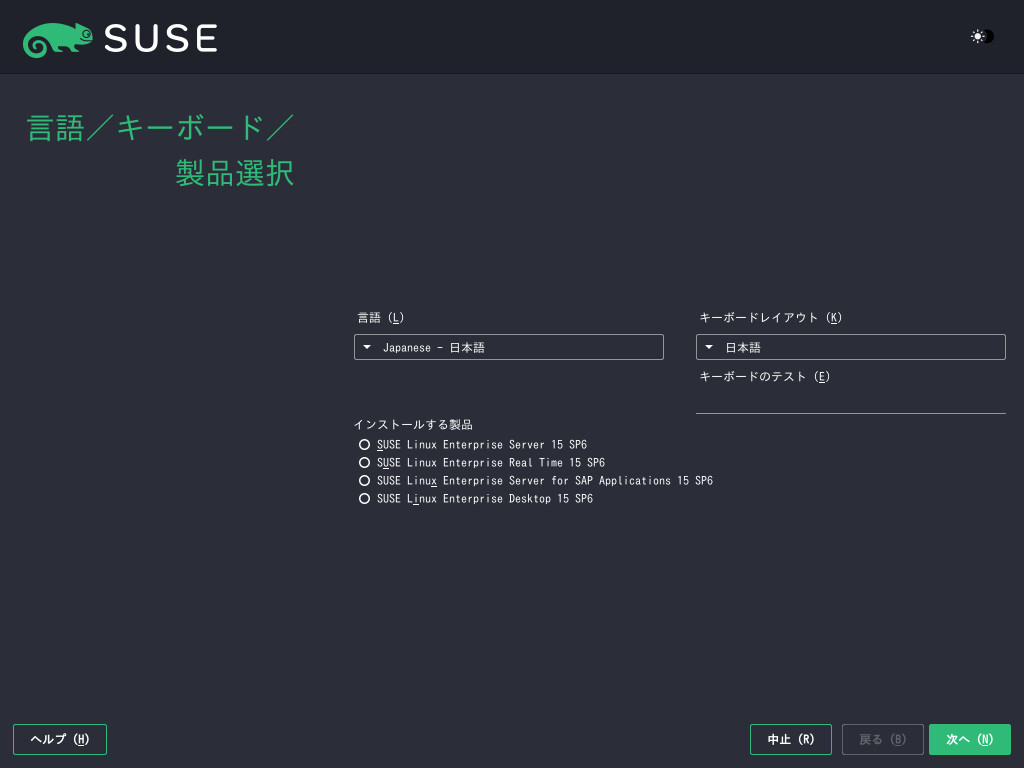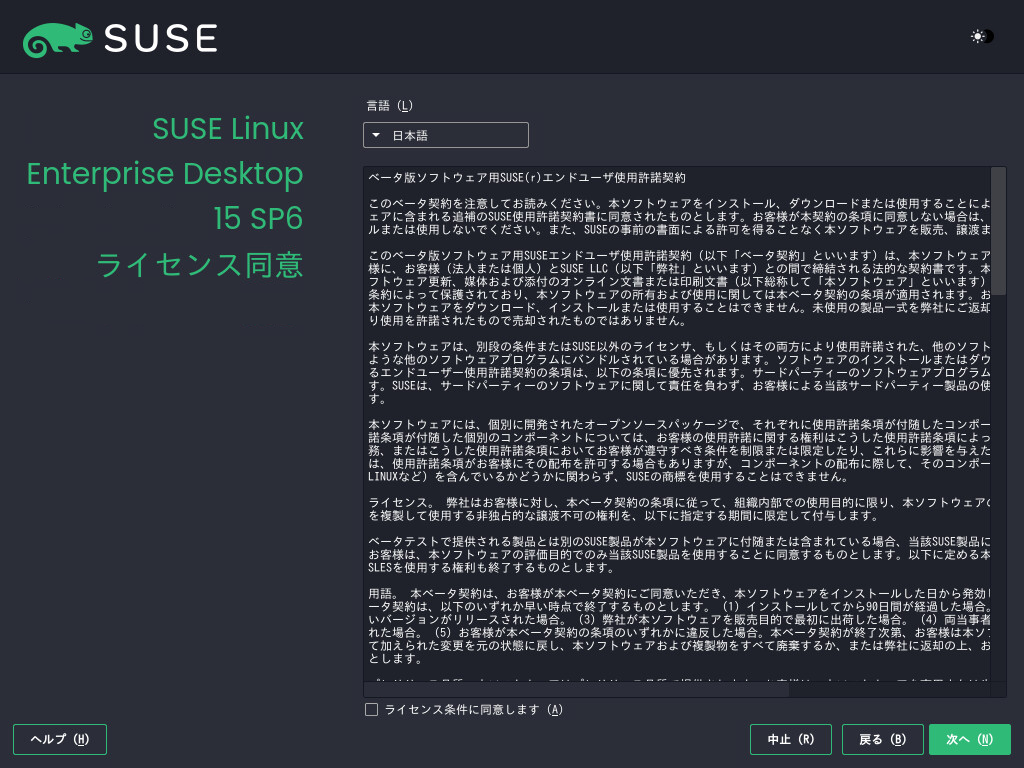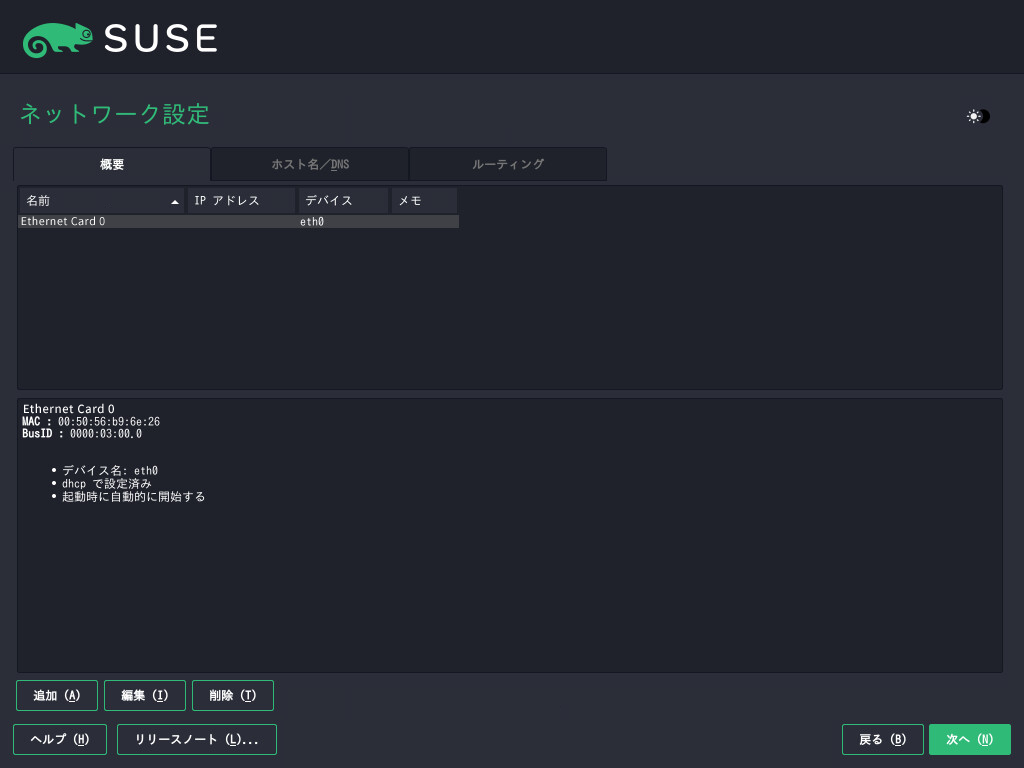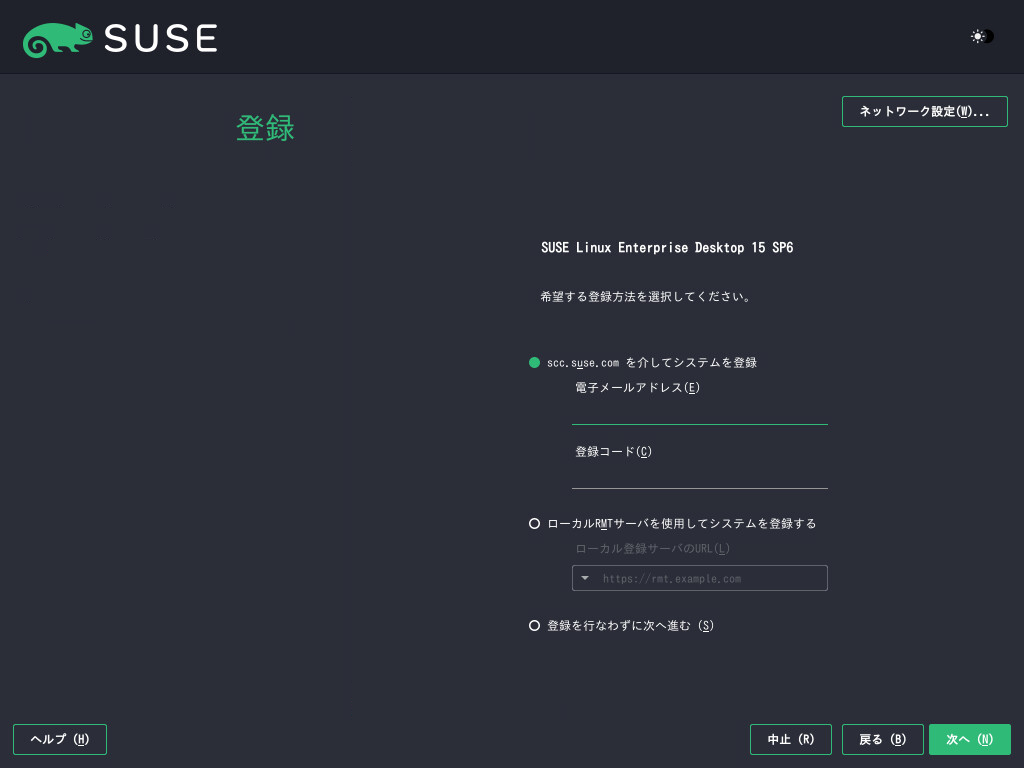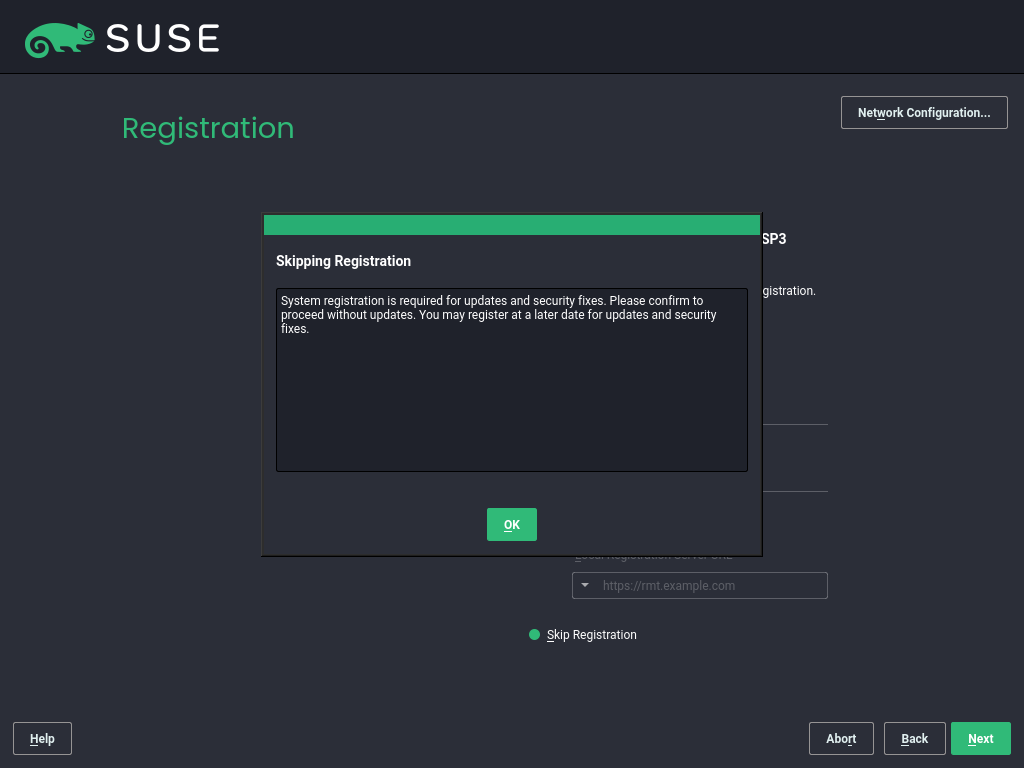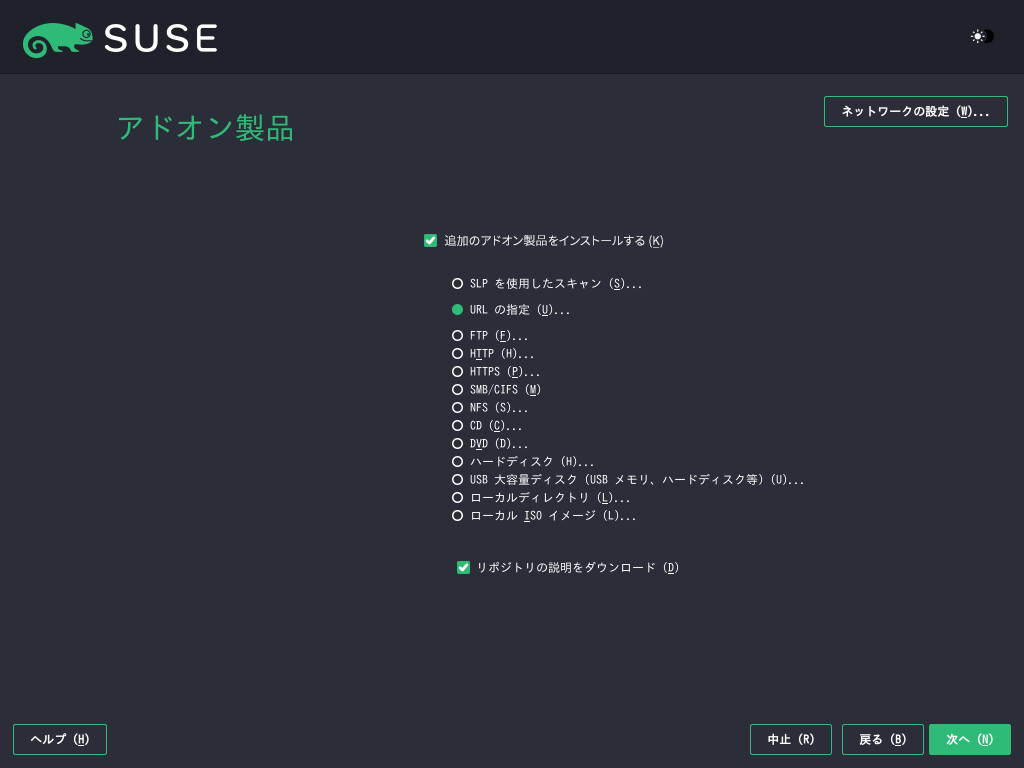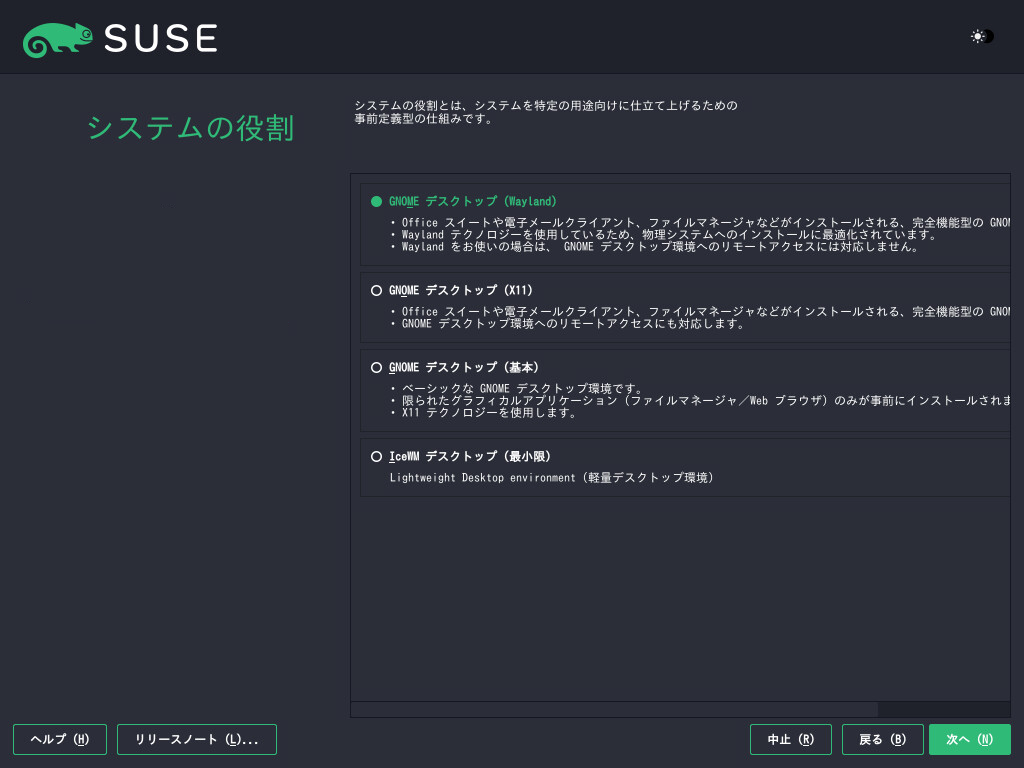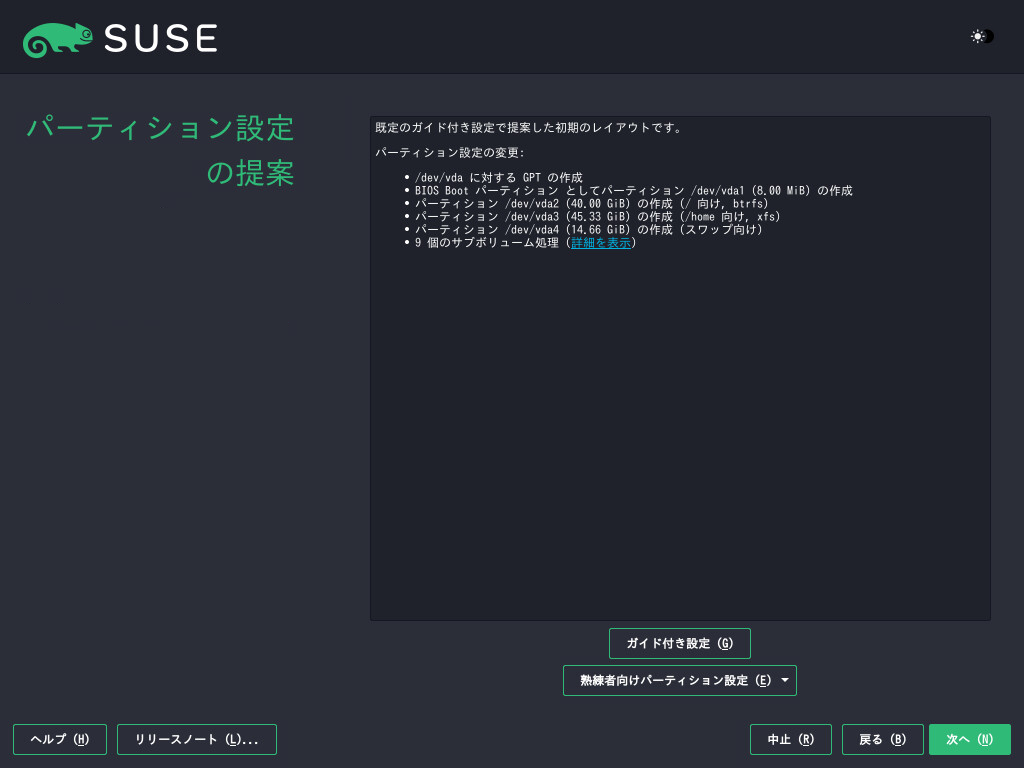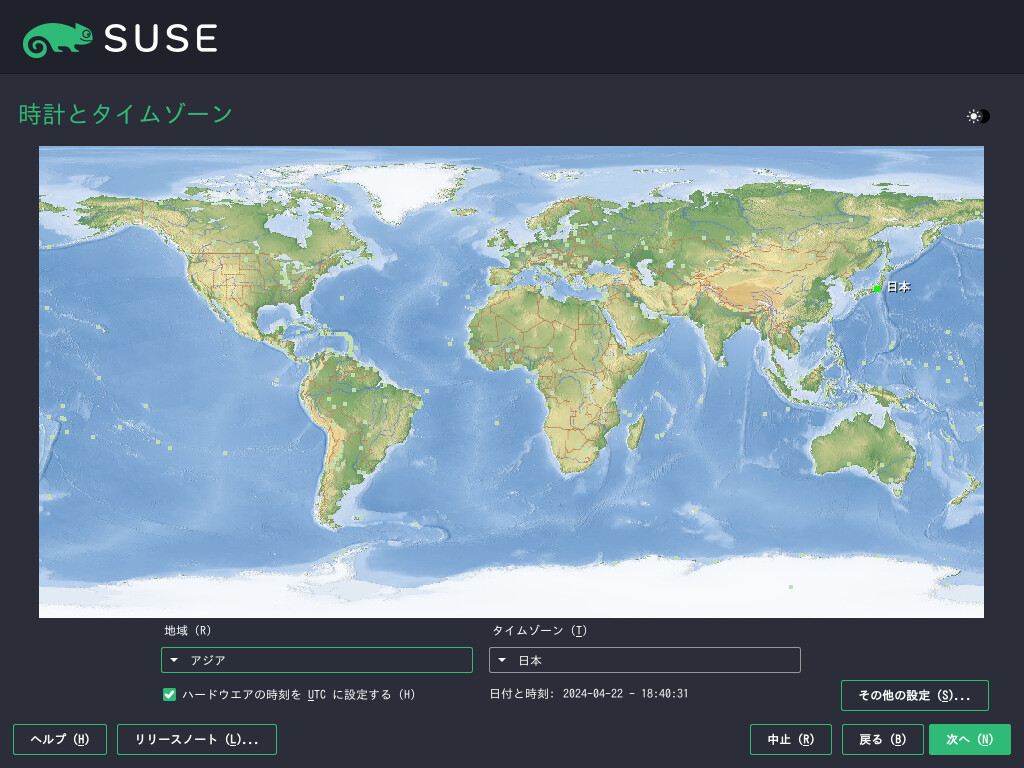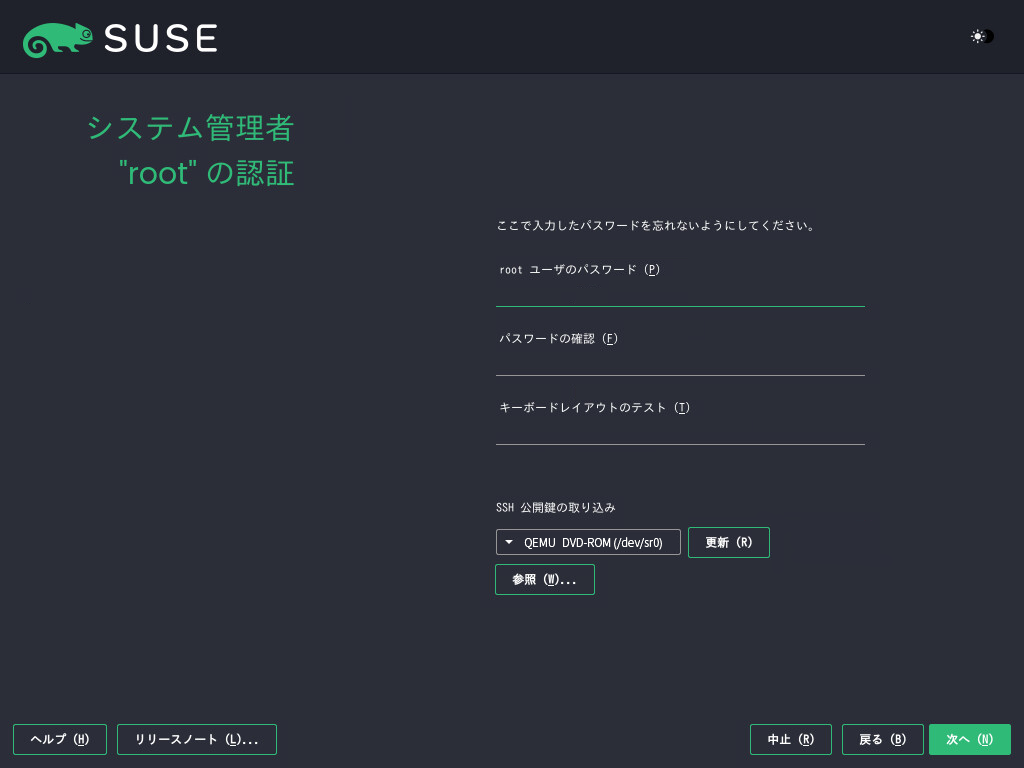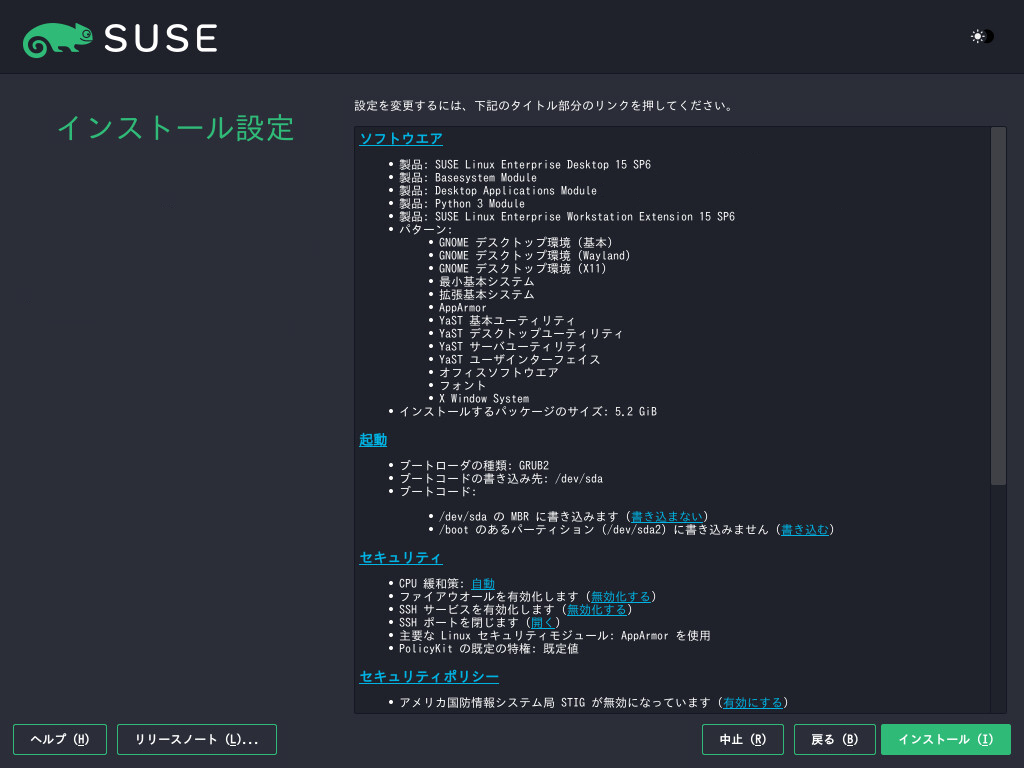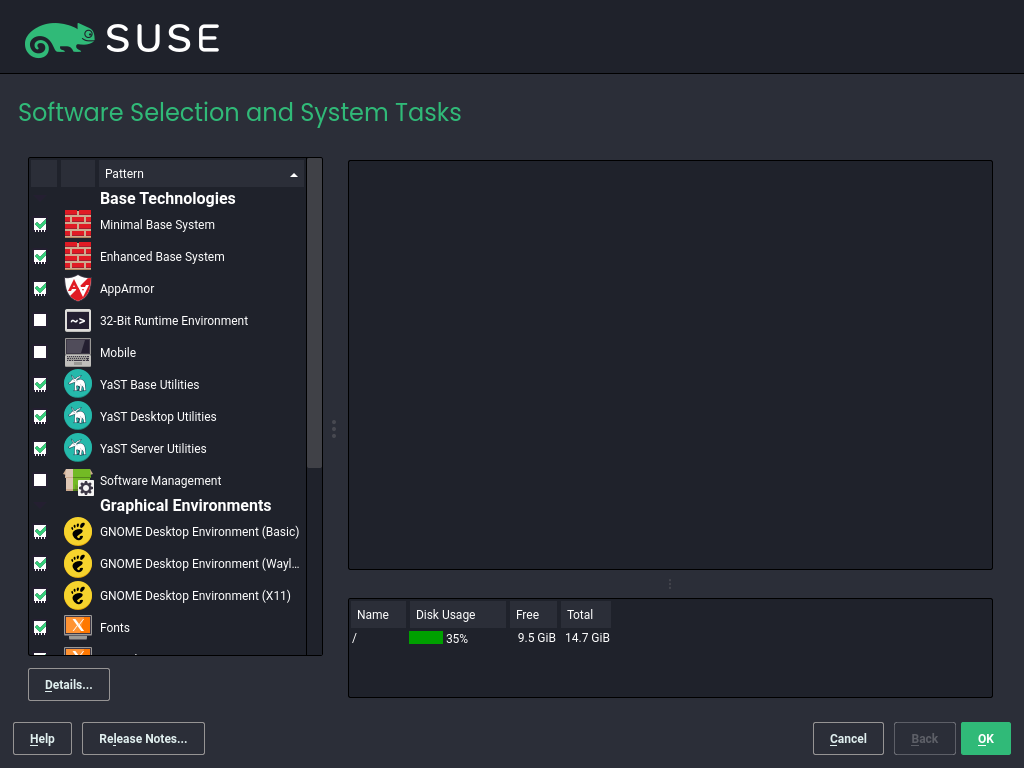5 Installation steps #
This chapter describes the procedure in which the data for SUSE Linux Enterprise Desktop is copied to the target device. Some basic configuration parameters for the newly installed system are set during the procedure. A graphical user interface will guide you through the installation. The procedure described in the following also applies to remote installation procedures as described in Chapter 8, Remote installation. The text mode installation has the same steps and only looks different.
If you are a first-time user of SUSE Linux Enterprise Desktop, you should follow the default YaST proposals in most parts, but you can also adjust the settings as described here to fine-tune your system according to your preferences. Help for each installation step is provided by clicking .
If the installer does not detect your mouse correctly, use →| for navigation, arrow keys to scroll, and Enter to confirm a selection. Various buttons or selection fields contain a letter with an underscore. Use Alt–Letter to select a button or a selection directly instead of navigating there with →|.
5.1 Overview #
This section provides an overview of all installation steps. Each step contains a link to a more detailed description.
Before the installation starts, the installer may update itself. For details, see Section 5.2, “Installer self-update”.
The actual installation starts with choosing the language and the product. For details, see Section 5.3, “ Language, keyboard and product selection ”.
Accept the license agreement. For details, see Section 5.4, “License agreement”.
Configure the network. This is only required when you need network access during the installation, and automatic network configuration via DHCP fails. If the automatic network configuration succeeds, this step is skipped. For details, see Section 5.5, “Network settings”.
With a working network connection you can register the machine at the SUSE Customer Center or an RMT server. For details, see Section 5.6, “Registration”.
Select the modules you want to enable for the machine. This impacts the availability of system roles in the next step and packages later on. For details, see Section 5.7, “Extension and module selection”.
You can manually add repositories. For details, see Section 5.8, “Add-on product”.
Select a role for your system. This defines the default list of packages to install and makes a suggestion for partitioning the hard disks. For details, see Section 5.9, “System roles”.
Partition the hard disks of your system. For details, see Section 5.10, “Partitioning”.
Choose a time zone. For details, see Section 5.11, “Clock and time zone”.
Create a user. For details, see Section 5.12, “Create new user”.
(Optional) Optionally, set a different password for the system administrator
root. For details, see Section 5.13, “Authentication for the system administratorroot”.In a final step, the installer presents an overview of all settings. If required, you can change them. For details, see Section 5.14, “Installation settings”.
The installer copies all required data and informs you about the progress. For details, see Section 5.15, “Performing the installation”.
5.2 Installer self-update #
During the installation and upgrade process, YaST may update itself to
solve bugs in the installer that were discovered after the release. This
functionality is enabled by default; to disable it, set the boot parameter
self_update to 0. For more information,
see Section 4.4.6, “Enabling the installer self-update”.
The installer self-update is only available if you use the GM
images of the Unified Installer and Packages ISOs. If you install from the ISOs published
as quarterly update (they can be identified by the string QU
in the name), the installer cannot update itself, because this feature is
disabled in the update media.
To download installer updates, YaST needs network access. By default, it tries to use DHCP on all network interfaces. If there is a DHCP server in the network, it will work automatically.
If you need a static IP setup, you can use the ifcfg
boot argument. For more details, see the linuxrc documentation at
https://en.opensuse.org/Linuxrc.
The installer self-update runs before the language selection step. This means that progress and errors which happen during this process are displayed in English by default.
To use another language for this part of the installer, use the
language boot parameter if available for your
architecture, for example, language=de_DE. On machines
equipped with a traditional BIOS, alternatively, press F2
in the boot menu and select the language from the list.
Although this feature was designed to run without user intervention, it is worth knowing how it works. If you are not interested, you can jump directly to Section 5.3, “ Language, keyboard and product selection ” and skip the rest of this section.
5.2.1 Self-update process #
The process can be broken down into two different parts:
Determine the update repository location.
Download and apply the updates to the installation system.
5.2.1.1 Determining the update repository location #
Installer Self-Updates are distributed as regular RPM packages via a dedicated repository, so the first step is to find the repository URL.
No matter which of the following options you use, only the installer self-update repository URL is expected, for example:
self_update=https://www.example.com/my_installer_updates/
Do not supply any other repository URL—for example the URL of the software update repository.
YaST will try the following sources of information:
The
self_updateboot parameter. (For more details, see Section 4.4.6, “Enabling the installer self-update”.) If you specify a URL, it will take precedence over any other method.The
/general/self_update_urlprofile element in case you are using AutoYaST.A registration server. YaST will query the registration server for the URL. The server to be used is determined in the following order:
By evaluating the
regurlboot parameter (Section 4.4.1, “Providing data to access a Repository Mirroring Tool server”).By evaluating the
/suse_register/reg_serverprofile element if you are using AutoYaST.By performing an SLP lookup. If an SLP server is found, YaST will ask you whether it should be used because there is no authentication involved and anybody on the local network can broadcast a registration server.
By querying the SUSE Customer Center.
If none of the previous attempts work, the fallback URL (defined in the installation media) will be used.
5.2.1.2 Downloading and applying the updates #
When the update repository is determined, YaST checks whether an update is available. If it is, all the updates are downloaded and applied.
Finally, YaST restarts and displays the welcome screen. If no updates are available, the installation continues without restarting YaST.
Update signatures will be checked to ensure integrity and authorship. If a signature is missing or invalid, you will be asked whether you want to apply the update.
5.2.1.3 Temporary self-update add-on repository #
Some packages distributed in the self-update repository provide additional data for the installer, like installation defaults, system role definitions and similar. If the installer finds such packages in the self-update repository, a local temporary repository is created, to which those packages are copied. They are used during the installation. The temporary local repository is removed at the end of the installation. Its packages are not installed on the target system.
This additional repository is not displayed in the list of add-on
products, but during installation it may still be visible as
SelfUpdate0 repository in the package management.
5.2.2 Custom self-update repositories #
YaST can use a user-defined repository instead of the official
repository by specifying a URL through the
self_update boot parameter.
HTTP/HTTPS and FTP repositories are supported.
Starting with yast2-installation-4.4.30, the
relurl://schema is supported, as a boot parameter or in an AutoYaST profile. The URL is relative to the main installation repository, and you may navigate the file tree with the usual../notation, for example relurl://../self_update. This is useful when serving the packages via a local installation server, or when building a custom installation medium which includes a self-update repository.The following examples assume the installation repository is at the medium root (/), and the self-update repository in the
self_updatesubdirectory. This structure makes therelurl://portable, and it will work anywhere without changes as a boot parameter, copied to a USB stick, hard disk, network server, or in an AutoYaST profile.- Custom DVD/USB medium
Add the
self_update=relurl://self_updateboot option directly to the default boot parameters, and it will work properly even if the medium is copied to an USB stick, hard disk, or a network server.- Installation server
Assume that the installation packages are available via http://example.com/repo and a self-update repository is available at http://example.com/self_update.
Then you can use the http://example.com/repo and http://example.com/self_update boot parameters, without having to change the
self_updateparameter when the repositories are moved to a different location.
Only RPM-MD repositories are supported (required by RMT).
Packages are not installed in the usual way: They are uncompressed only and no scripts are executed.
No dependency checks are performed. Packages are installed in alphabetical order.
Files from the packages override the files from the original installation media. This means that the update packages might not need to contain all files, only files that have changed. Unchanged files are omitted to save memory and download bandwidth.
Currently, it is not possible to use more than one repository as source for installer self-updates.
5.3 Language, keyboard and product selection #
The and settings are initialized with the language you chose on the boot screen. If you did not change the default, it will be English (US). Change the settings here, if necessary.
Changing the language automatically selects a corresponding keyboard layout. You can override this proposal by selecting a different keyboard layout from the drop-down box. Use the text box to test the layout. The selected language also determines a time zone for the system clock. This setting can be modified later as described in 第5章 「YaSTによる言語および国の設定の変更」.
With the Unified Installer, you can install all SUSE Linux Enterprise base products:
SUSE Linux Enterprise Server 15 SP6 (for installation instructions, refer to https://documentation.suse.com/sles/)
SUSE Linux Enterprise Desktop 15 SP6 (covered here)
SUSE Linux Enterprise Real Time 15 SP6 (for installation instructions, refer to https://documentation.suse.com/sle-rt/)
SUSE Linux Enterprise Server for SAP applications 15 SP6 (for installation instructions, refer to https://documentation.suse.com/sles-sap)
Select a product for installation. You need to have a registration code for the respective product. In this document it is assumed you have chosen SUSE Linux Enterprise Desktop. Proceed with .
If you have difficulties reading the labels in the installer, you can change the widget colors and theme.
Click the
button or press Shift–F3
to open a theme selection dialog. Select a theme from the list and
the dialog.
Shift–F4 switches to the color scheme for vision-impaired users. Press the buttons again to switch back to the default scheme.
5.4 License agreement #
Read the License Agreement. It is presented in the language you have chosen on the boot screen. Translations are available via the drop-down box. If you agree to the terms, check and click to proceed with the installation. If you do not agree to the license agreement, you cannot install SUSE Linux Enterprise Desktop; click to terminate the installation.
5.5 Network settings #
After booting into the installation, the installation routine is set up. During this setup, an attempt to configure at least one network interface with DHCP is made. In case this attempt has failed, the dialog launches now.
Choose a network interface from the list and click to change its settings. Use the tabs to configure DNS and routing. See 23.4項 「YaSTによるネットワーク接続の設定」 for more details.
In case DHCP was successfully configured during installation setup, you can also access this dialog by clicking at the and the step. It lets you change the automatically provided settings.
If at least one network interface has been configured via boot parameters (see Section 4.3.2, “Configuring the network interface”), automatic DHCP configuration is disabled and the boot parameter configuration is imported and used.
To access a SAN or a local RAID during the installation, you can use the libstorage command line client for this purpose:
Switch to a console with Ctrl–Alt–F2.
Install the libstoragemgmt extension by running
extend libstoragemgmt.Now you have access to the
lsmclicommand. For more information, runlsmcli --help.To return to the installer, press Alt–F7
Supported are Netapp Ontap, all SMI-S compatible SAN providers, and LSI MegaRAID.
5.6 Registration #
To get technical support and product updates, you need to register and activate SUSE Linux Enterprise Desktop with the SUSE Customer Center or a local registration server. Registering your product at this stage also grants you immediate access to the update repository. This enables you to install the system with the latest updates and patches available.
When registering, repositories and dependencies for modules and extensions are loaded from the registration server.
From this dialog, you can switch to the YaST module by clicking . For details, see 23.4項 「YaSTによるネットワーク接続の設定」.
If you are offline or want to skip registration, activate . See Section 5.6.3, “Installing without registration” for instructions.
5.6.1 Manual registration #
To register with the SUSE Customer Center, provide the associated with your SCC account and the for SUSE Linux Enterprise Desktop.
If your organization offers a local registration server, you may register there. Activate and either choose a URL from the drop-down box or type in an address. Proceed with .
To register with the SUSE Customer Center, enter your for SUSE Linux Enterprise Desktop. If your organization provides a local registration server, you may register there. Activate and either choose a URL from the drop-down box or type in an address.
Start the registration process with .
Depending on your hardware, additional repositories containing hardware drivers may be added during the registration. If so, you will be asked to each of these repositories.
After SUSE Linux Enterprise Desktop has been successfully registered, you are asked whether to install the latest available online updates during the installation. If you choose , the system will be installed with the most current packages without having to apply updates after installation. It is recommended to enable this option.
By default, the firewall on SUSE Linux Enterprise Desktop only blocks incoming connections.
If your system is behind another firewall that blocks outgoing traffic,
make sure to allow connections to https://scc.suse.com/ and
https://updates.suse.com on ports 80 and 443 in order
to receive updates.
If the system is successfully registered during installation, YaST disables repositories from local installation media such as CD/DVD or flash disks when the installation completes. This prevents problems caused by the missing installation source and ensures that you always get the latest updates from the online repositories.
5.6.2 Loading registration codes from USB storage #
To make the registration more convenient, you can also store your registration codes on a USB storage device such as a flash disk. YaST will automatically pre-fill the corresponding text box. This is particularly useful when testing the installation or if you need to register many systems or extensions.
Create a file named regcodes.txt or
regcodes.xml on the USB disk. If both are present, the
XML takes precedence.
In that file, identify the product with the name returned by
zypper search --type product and assign it a
registration code as follows:
regcodes.txt #SLES cc36aae1 SLED 309105d4 sle-we 5eedd26a sle-live-patching 8c541494
regcodes.xml #<?xml version="1.0"?>
<profile xmlns="http://www.suse.com/1.0/yast2ns"
xmlns:config="http://www.suse.com/1.0/configns">
<suse_register>
<addons config:type="list">
<addon>
<name>SLES</name>
<reg_code>cc36aae1</reg_code>
</addon>
<addon>
<name>SLED</name>
<reg_code>309105d4</reg_code>
</addon>
<addon>
<name>sle-we</name>
<reg_code>5eedd26a</reg_code>
</addon>
<addon>
<name>sle-live-patching</name>
<reg_code>8c541494</reg_code>
</addon>
</addons>
</suse_register>
</profile>
Note that SLES and SLED are not
extensions, but listing them as add-ons allows for combining several base
product registration codes in a single file.
Currently flash disks are only scanned during installation or upgrade, but not when registering a running system.
5.6.3 Installing without registration #
If you are offline or want to skip registration, activate . Accept the warning with and proceed with .
Your system and extensions need to be registered to retrieve
updates and to be eligible for support. Skipping the registration is
only possible when installing from the
SLE-15-SP6-Full-ARCH-GM-media1.iso image.
Your system and extensions need to be registered to retrieve updates and to be eligible for support. If you do not register during the installation, you can do so at any time later from the running system. To do so, run › .
Use the following command to copy the contents of the installation image to a removable flash disk.
>sudodd if=IMAGE of=FLASH_DISK bs=4M && sync
IMAGE needs to be replaced with the path to the
SLE-15-SP6-Online-ARCH-GM-media1.iso or SLE-15-SP6-Full-ARCH-GM-media1.iso
image file. FLASH_DISK needs to be replaced
with the flash device. To identify the device, insert it and run:
# grep -Ff <(hwinfo --disk --short) <(hwinfo --usb --short)
disk:
/dev/sdc General USB Flash DiskMake sure the size of the device is sufficient for the desired image. You can check the size of the device with:
# fdisk -l /dev/sdc | grep -e "^/dev"
/dev/sdc1 * 2048 31490047 31488000 15G 83 Linux
In this example, the device has a capacity of 15 GB. The command to use for
the SLE-15-SP6-Full-ARCH-GM-media1.iso would be:
dd if=SLE-15-SP6-Full-ARCH-GM-media1.iso of=/dev/sdc bs=4M && sync
The device must not be mounted when running the dd
command. Note that all data on the partition will be erased!
5.7 Extension and module selection #
In this dialog the installer lists modules and extensions that are available for SUSE Linux Enterprise Desktop. Modules are components that allow you to customize the product according to your needs. They are included in your SUSE Linux Enterprise Desktop subscription. Extensions add functionality to your product. They must be purchased separately.
The availability of certain modules or extensions depends on the product you chose in the first step of this installation. For a description of the modules and their lifecycles, select a module to see the accompanying text. More detailed information is available in the Modules and Extensions Quick Start.
The selection of modules indirectly affects the scope of the installation, because it defines which software sources (repositories) are available for installation and in the running system.
The following modules and extensions are available for SUSE Linux Enterprise Desktop:
- Basesystem Module
This module adds a basic system on top of the Unified Installer. It is required by all other modules and extensions. The scope of an installation that only contains the base system is comparable to the installation pattern minimal system of previous SUSE Linux Enterprise Desktop versions. This module is selected for installation by default and should not be deselected.
Dependencies: None
- Certifications Module
Contains the FIPS certification packages.
Dependencies: Server Applications
- Desktop Applications Module
Adds a graphical user interface and essential desktop applications to the system. This module is selected for installation by default; deselecting it is not recommended.
Dependencies: Basesystem
- Development Tools Module
Contains compilers (including gcc) and libraries required for compiling and debugging applications. Replaces the former Software Development Kit (SDK).
Dependencies: Basesystem, Desktop Applications
- Python 3 Module
This module contains the most recent version of the selected Python 3 packages.
Dependencies: Basesystem
- SUSE Linux Enterprise Workstation Extension
Contains additional desktop tools such as an office suite or multimedia software such as music and video players. This extension is included in the SUSE Linux Enterprise Desktop subscription and is selected for installation by default; deselecting it is not recommended.
Dependencies: Basesystem, Desktop Applications
- SUSE Package Hub
Provides access to packages for SUSE Linux Enterprise Desktop maintained by the openSUSE community. These packages are delivered without L3 support and do not interfere with the supportability of SUSE Linux Enterprise Desktop. For more information, refer to https://packagehub.suse.com/.
Dependencies: Basesystem
Some modules depend on the installation of other modules. Therefore, when selecting a module, other modules may be selected automatically to fulfill dependencies.
Depending on the product, the registration server can mark modules and extensions as recommended. Recommended modules and extensions are preselected for registration and installation. To avoid installing these recommendations, deselect them manually.
Select the modules and extensions you want to install and proceed with . In case you have chosen one or more extensions, you will be prompted to provide the respective registration codes. Depending on your choice, it may also be necessary to accept additional license agreements.
When performing an offline installation from the SLE-15-SP6-Full-ARCH-GM-media1.iso, only the is selected by default. To install the complete default package set of SUSE Linux Enterprise Desktop, additionally select the , the , and the .
5.8 Add-on product #
The dialog allows you to add additional software sources (so-called “repositories”) to SUSE Linux Enterprise Desktop, that are not provided by the SUSE Customer Center. Such add-on products may include third-party products and drivers or additional software for your system.
From this dialog, you can switch to the YaST module by clicking . For details, see 23.4項 「YaSTによるネットワーク接続の設定」.
You can also add driver update repositories via the dialog. Driver updates for SUSE Linux Enterprise are provided at https://drivers.suse.com/. These drivers have been created via the SUSE SolidDriver Program.
If you do not want to install add-ons, proceed with . Otherwise activate . Specify the Media Type by choosing from CD, DVD, Hard Disk, USB Mass Storage, a Local Directory or a Local ISO Image. If network access has been configured you can choose from additional remote sources such as HTTP, SLP, FTP, etc. Alternatively you may directly specify a URL. Check to download the files describing the repository now. If deactivated, they will be downloaded after the installation starts. Proceed with and insert a CD or DVD if required.
Depending on the add-on's content, it may be necessary to accept additional license agreements.
5.9 System roles #
To simplify the installation, the installer offers predefined use cases that tailor the system for the selected scenario.
Choose the that meets your requirements best. The availability of system roles depends on your selection of modules and extensions. The dialog is omitted under the following conditions:
The combination of base product and modules does not allow roles to be chosen.
The combination of base product and modules only allows a single role.
With the default selection, the following system roles are available:
Installs a fully featured GNOME desktop environment, including office suite, e-mail client, Web browser, and file manager. It is optimized for installation on physical systems, using the Wayland technology. Does not support accessing the desktop from a remote machine.
Dependencies: Basesystem, Desktop Applications, SUSE Linux Enterprise Workstation Extension
Installs a fully featured GNOME desktop environment, including office suite, e-mail client, Web browser, and file manager. Comes with support for accessing the desktop from a remote machine.
Dependencies: Basesystem, Desktop Applications, SUSE Linux Enterprise Workstation Extension
Installs a GNOME desktop environment with only essential graphical applications (for example file manager, Web browser). It is using the X11 technology.
Dependencies: Basesystem, Desktop Applications
Installs a lightweight IceWM desktop environment with only a bare minimum of graphical applications (for example xterm). It is using the X11 technology.
Dependencies: Basesystem
5.10 Partitioning #
5.10.1 Important information #
Read this section carefully before continuing with Section 5.10.2, “Suggested partitioning”.
- Custom partitioning on UEFI machines
A UEFI machine requires an EFI system partition that must be mounted to
/boot/efi. This partition must be formatted with theFAT32file system.If an EFI system partition is already present on your system (for example from a previous Windows installation) use it by mounting it to
/boot/efiwithout formatting it.If no EFI system partition is present on your UEFI machine, make sure to create it. The EFI system partition must be a physical partition or RAID 1. Other RAID levels, LVM and other technologies are not supported. It needs to be formatted with the FAT32 file system.
- Custom partitioning and
Snapper SUSE Linux Enterprise Desktop can be configured to use snapshots which provide the ability to do rollbacks of system changes.
SUSE Linux Enterprise Desktop uses Snapper together with Btrfs for this feature. Btrfs needs to be set up with snapshots enabled for the root partition.
If the disk is smaller than 16 GB, all Snapper features and automatic snapshots are disabled to prevent the system partition
/from running out of space.Being able to create system snapshots that enable rollbacks requires important system directories to be mounted on a single partition, for example
/usrand/var. Only directories that are excluded from snapshots may reside on separate partitions, for example/usr/local,/var/log, and/tmp.If snapshots are enabled, the installer will automatically create
singlesnapshots during and immediately after the installation.For details, see 第10章 「Snapperを使用したシステムの回復とスナップショット管理」.
Important: Btrfs snapshots and root partition sizeSnapshots may take considerable storage space. Generally, the older a snapshot is or the larger the changeset it covers, the more storage space the snapshot takes. And the more snapshots you keep, the more disk space you need.
To prevent the root partition running full with snapshot data, you need to make sure it is big enough. In case you do frequent updates or other installations, consider at least 30 GB for the root partition. If you plan to keep snapshots activated for a system upgrade or a service pack migration (to be able to roll back), you should consider 40 GB or more.
- Btrfs data volumes
Using Btrfs for data volumes is supported on SUSE Linux Enterprise Desktop 15 SP6. For applications that require Btrfs as a data volume, consider creating a separate file system with quota groups disabled. This is already the default for non-root file systems.
- Btrfs on an encrypted root partition
The default partitioning setup suggests the root partition as Btrfs. To encrypt the root partition, make sure to use the GPT partition table type instead of the MSDOS type. Otherwise the GRUB2 boot loader may not have enough space for the second stage loader.
- Supported software RAID volumes
Installing to and booting from existing software RAID volumes is supported for Disk Data Format (DDF) volumes and Intel Matrix Storage Manager (IMSM) volumes. IMSM is also known by the following names:
Intel Rapid Storage Technology
Intel Matrix Storage Technology
Intel Application Accelerator / Intel Application Accelerator RAID Edition
Intel Virtual RAID on CPU (Intel VROC, see https://www.intel.com/content/www/us/en/support/articles/000024498/memory-and-storage/ssd-software.html for more details)
- Mount points for FCoE and iSCSI devices
FCoE and iSCSI devices will appear asynchronously during the boot process. While the initrd guarantees that those devices are set up correctly for the root file system, there are no such guarantees for any other file systems or mount points like
/usr. Hence any system mount points like/usror/varare not supported. To use those devices, ensure correct synchronization of the respective services and devices.- Handling of Windows partitions in proposals
In case the disk selected for the suggested partitioning proposal contains a large Windows FAT or NTFS partition, it will automatically be resized to make room for the SUSE Linux Enterprise Desktop installation. To avoid data loss it is strongly recommended to
make sure the partition is not fragmented (run a defragmentation program from Windows prior to the SUSE Linux Enterprise Desktop installation)
double-check the suggested size for the Windows partition is big enough
back up your data prior to the SUSE Linux Enterprise Desktop installation
To adjust the proposed size of the Windows partition, use the .
5.10.2 Suggested partitioning #
Define a partition setup for SUSE Linux Enterprise Desktop in this step.
The installer creates a proposal for one of the available disks containing a root partition formatted with Btrfs and a swap partition. If one or more swap partitions have been detected on the available hard disks, these partitions will be used. You have several options to proceed:
To accept the proposal without any changes, click to proceed with the installation workflow.
To adjust the proposal, choose . First, choose which hard disks and partitions to use. In the screen, you can enable Logical Volume Management (LVM) and activate disk encryption. Afterward specify the . You can adjust the file system for the root partition and create a separate home and swap partitions. If you plan to suspend your machine, make sure to create a separate swap partition and check . If the root file system format is Btrfs, you can also enable or disable Btrfs snapshots here.
To create a custom partition setup click . Select either if you want start with the suggested disk layout, or to ignore the suggested layout and start with the existing layout on the disk. You can , , , or partitions.
You can also set up logical volume management (LVM), configure software RAID and device mapping (DM), encrypt partitions, mount NFS shares and manage tmpfs volumes with the . To fine-tune settings such as the subvolume and snapshot handling for each Btrfs partition, choose . For more information about custom partitioning and configuring advanced features, refer to Section 7.1, “Using the ”.
Note that for partitioning purposes, disk space is measured in binary
units, rather than in decimal units. For example, if you enter sizes of
1GB, 1GiB or 1G,
they all signify 1 GiB (Gibibyte), as opposed to 1 GB (Gigabyte).
- Binary
1 GiB = 1 073 741 824 bytes.
- Decimal
1 GB = 1 000 000 000 bytes.
- Difference
1 GiB ≈ 1.07 GB.
5.11 Clock and time zone #
In this dialog, select your region and time zone. Both are preselected according to the installation language.
To change the preselected values, either use the map or the drop-down boxes for and . When using the map, point the cursor at the rough direction of your region and left-click to zoom. Now choose your country or region by left-clicking. Right-click to return to the world map.
To set up the clock, choose whether the . If you run another operating system on your machine, such as Microsoft Windows, it is likely your system uses local time instead. If you run Linux on your machine, set the hardware clock to UTC and have the switch from standard time to daylight saving time performed automatically.
The switch from standard time to daylight saving time (and vice versa) can only be performed automatically when the hardware clock (CMOS clock) is set to UTC. This also applies if you use automatic time synchronization with NTP, because automatic synchronization will only be performed if the time difference between the hardware and system clock is less than 15 minutes.
Since a wrong system time can cause serious problems (missed backups, dropped mail messages, mount failures on remote file systems, etc.), it is strongly recommended to always set the hardware clock to UTC.
If a network is already configured, you can configure time synchronization with an NTP server. Click to either alter the NTP settings or to set the time. See 第39章 「NTPによる時刻の同期」 for more information on configuring the NTP service. When finished, click to continue the installation.
If running without NTP configured, consider setting
SYSTOHC=no (sysconfig variable) to
avoid saving unsynchronized time into the hardware clock.
5.12 Create new user #
Create a local user in this step.
After entering the first name and last name, either accept the proposal or
specify a new that will be used to log in. Only
use lowercase letters (a-z), digits (0-9) and the characters
. (dot), - (hyphen) and
_ (underscore). Special characters, umlauts and accented
characters are not allowed.
Finally, enter a password for the user. Re-enter it for confirmation (to ensure that you did not type something else by mistake). To provide effective security, a password should be at least six characters long and consist of uppercase and lowercase letters, numbers and special characters (7-bit ASCII). Umlauts or accented characters are not allowed. Passwords you enter are checked for weakness. When entering a password that is easy to guess (such as a dictionary word or a name) you will see a warning. It is a good security practice to use strong passwords.
Remember both your user name and the password because they are needed each time you log in to the system.
If you install SUSE Linux Enterprise Desktop on a machine with one or more existing Linux installations, YaST allows you to import user data such as user names and passwords. Select and then for import.
If you do not want to configure any local users (for example when setting up a client on a network with centralized user authentication), skip this step by choosing and confirming the warning. Network user authentication can be configured at any time later in the installed system; refer to 第6章 「YaSTによるユーザの管理」 for instructions.
Two additional options are available:
If checked, the same password you have entered for the user will be used for the system administrator
root. This option is suitable for stand-alone workstations or machines in a home network that are administrated by a single user. When not checked, you are prompted for a system administrator password in the next step of the installation workflow (see Section 5.13, “Authentication for the system administratorroot”).This option automatically logs the current user in to the system when it starts. This is mainly useful if the computer is operated by only one user.
With the automatic login enabled, the system boots straight into your desktop with no authentication. If you store sensitive data on your system, you should not enable this option if the computer can also be accessed by others.
In an environment where users are centrally managed (for example by NIS or LDAP) you should skip the creation of local users. Select in this case.
5.13 Authentication for the system administrator root #
If you have not chosen in the previous step, you will be prompted to enter
a password for the system administrator root or provide a public SSH
key. Otherwise, this configuration step is skipped.
root #
Enter the password for the system administrator root. For verification purposes, the
password for root must be entered twice. Do not forget the password as it cannot be
retrieved later.
It is recommended to only use US ASCII characters. In case of a system error or when you need to start your system in rescue mode, the keyboard may not be localized.
To change the root password later in the installed system, run YaST and start
› .
root user
root is the name of the system administrator or superuser. Its user ID (uid) is
0. Unlike regular users, the root account has unlimited privileges.
- Do not forget the
rootpassword Only
roothas the privileges to change the system configuration, install programs, manage users and set up new hardware. To carry out such tasks, therootpassword is required. Do not forget the password as it cannot be retrieved later.- Do not use the
rootuser for daily work Logging in as
rootfor daily work is rather risky: Commands fromrootare usually executed without additional confirmation, so a single mistake can lead to an irretrievable loss of system files. Only use therootaccount for system administration, maintenance and repair.- Do not rename the
rootuser account YaST will always name the system administrator
root. While it is technically possible to rename therootaccount, certain applications, scripts or third-party products may rely on the existence of a user calledroot. While such a configuration always targets individual environments, necessary adjustments could be overwritten by vendor updates, so this becomes an ongoing task rather than a one-time setting. This is especially true in very complex setups involving third-party applications, where it needs to be verified with every vendor involved whether a rename of therootaccount is supported.As the implications for renaming the
rootaccount cannot be foreseen, SUSE does not support renaming therootaccount.Usually, the idea behind renaming the
rootaccount is to hide it or make it unpredictable. However,/etc/passwdrequires644permissions for regular users, so any user of the system can retrieve the login name for the user ID 0. For better ways to secure therootaccount, refer to Section 14.5, “Restrictingrootlogins” and Section 14.5.3, “Restricting SSH logins”.
If you want to access the system remotely via SSH using a public key, import a key from a removable storage device or an existing partition. After the installation is finished, you can log in through SSH using the provided SSH key.
root #To import a public SSH key from a medium partition, perform the following steps:
The public SSH key is located in your
~/.sshdirectory and has the file extension.pub. Copy it to a removable storage device or an existing partition that is not formatted during installation.If your key is on a removable storage device, insert it into your computer and click . You should see the device in the drop-down box under .
Click , select the public SSH key and confirm with .
Proceed with .
If you have both set a password and added a public SSH key, and need remote access right after the installation, do not forget to open the SSH port in the section of the summary. If you set no password but only add a key, the port will be opened automatically to prevent you from being locked out of the newly installed system.
5.14 Installation settings #
On the last step before the real installation takes place, you can alter installation settings suggested by the installer. To modify the suggestions, click the respective headline. After having made changes to a particular setting, you are always returned to the Installation Settings window, which is updated accordingly.
If you have added an SSH key for your root as mentioned in Procedure 5.1,
make sure to open the SSH port in the settings.
5.14.1 #
SUSE Linux Enterprise Desktop contains several software patterns for various application purposes. The available choice of patterns and packages depends on your selection of modules and extensions.
Click to open the screen where you can modify the pattern selection according to your needs. Select a pattern from the list and see a description in the right-hand part of the window.
Each pattern contains several software packages needed for specific functions (for example Multimedia or Office software). For a more detailed selection based on software packages to install, select to switch to the YaST Software Manager.
You can also install additional software packages or remove software packages from your system at any later time with the YaST Software Manager. For more information, refer to 第8章 「ソフトウェアをインストールまたは削除する」.
By default, SUSE Linux Enterprise Desktop uses the Wayland display server protocol.
The language you selected with the first step of the installation will be used as the primary (default) language for the system. You can add secondary languages from within the dialog by choosing › › .
5.14.2 #
The installer proposes a boot configuration for your system. Other operating systems found on your computer, such as Microsoft Windows or other Linux installations, will automatically be detected and added to the boot loader. However, SUSE Linux Enterprise Desktop will be booted by default. Normally, you can leave these settings unchanged. If you need a custom setup, modify the proposal according to your needs. For information, see 18.3項 「YaSTによるブートローダの設定」.
Booting a configuration where /boot resides on a
software RAID 1 device is supported, but it requires to install the boot
loader into the MBR ( › ). Having
/boot on software RAID devices with a level other
than RAID 1 is not supported.
5.14.3 #
The refer to kernel boot command line parameters for software mitigations that have been deployed to prevent CPU side-channel attacks. Click the selected entry to choose a different option. For details, see .
By default, the is enabled on all configured
network interfaces. To completely disable firewalld, click
(not recommended).
When the firewall is activated, all interfaces are assigned to the
public zone, where all ports are closed by default,
ensuring maximum security. The only port you can open during the
installation is port 22 (SSH), to allow remote access. Other services
requiring network access (such as FTP, Samba, Web server, etc.) will only
work after having adjusted the firewall settings. Refer to Chapter 23, Masquerading and firewalls for configuration details.
By default, the firewall on SUSE Linux Enterprise Desktop only blocks incoming connections.
If your system is behind another firewall that blocks outgoing traffic,
make sure to allow connections to https://scc.suse.com/ and
https://updates.suse.com on ports 80 and 443 in order
to receive updates.
The is enabled by default, but its port (22) is closed in the firewall. Click to open the port or to disable the service. Note that if SSH is disabled, remote logins will not be possible. Refer to Chapter 22, Securing network operations with OpenSSH for more information.
If you install SUSE Linux Enterprise Desktop on a machine with existing Linux installations, the installation routine imports an SSH host key. It chooses the host key with the most recent access time by default. See also Section 5.14.7, “”.
If you are performing a remote administration over VNC, you can also specify whether the machine should be accessible via VNC after the installation. Note that enabling VNC also requires you to set the to .
The default is . To disable it, select as module in the settings. This allows you to deselect the pattern in the settings (Section 5.14.1, “”).
5.14.4 #
This feature is available for SUSE Linux Enterprise 15 SP4 GM via installer self-update or using the QU2 media.
This category allows hardening your system with OpenSCAP security
policies. The first policy that was implemented is the
Security Technical Implementation Guide (STIG) by the Defense Information Systems Agency
(DISA).
Click to the security policy. Non-compliant installation settings will be listed with the rule they violate. Some settings can be adjusted automatically by clicking . For settings that require user input, click to open the respective settings screen.
If you do not want to wait for the screen, but want the installer to check the settings
from the beginning of the installation process, boot the system with the
boot parameter
YAST_SECURITY_POLICY=POLICY.
To check for compliance with the DISA STIG, use
YAST_SECURITY_POLICY=stig. For more information about
boot parameters, refer to Chapter 4, Boot parameters.
The installer does not check all rules of the profile, only those necessary for the installation or that are hard to fix afterward. To apply the remaining rules, a full SCAP remediation is performed on first boot. You can also perform a or and manually remediate the system later with OpenSCAP. For more information, refer to the articles Hardening SUSE Linux Enterprise with STIG and Hardening SUSE Linux Enterprise with OpenSCAP.
5.14.5 #
This category displays the current network settings, as automatically
configured after booting into the installation (see Section 5.5) or as manually
configured during the installation process. By default,
wicked is used for server installations and NetworkManager for desktop workloads.
If you want to check or adjust the network settings, click . This takes you to the YaST module. For details, see 23.4項 「YaSTによるネットワーク接続の設定」.
SUSE only supports NetworkManager for desktop workloads with SLED or the Workstation extension.
All server certifications are done with wicked as the network
configuration tool, and using NetworkManager may invalidate them. NetworkManager is not supported by SUSE for
server workloads.
5.14.6 #
SUSE Linux Enterprise Desktop can boot into two different targets (formerly known as “runlevels”). The target starts a display manager, whereas the target starts the command line interface.
The default target is . In case you have not installed the patterns, you need to change it to . If the system should be accessible via VNC, you need to choose .
5.14.7 #
If an existing Linux installation on your computer was detected, YaST
will import the most recent SSH host key found in
/etc/ssh by default, optionally including other files
in the directory as well. This makes it possible to reuse the SSH identity
of the existing installation, avoiding the REMOTE HOST
IDENTIFICATION HAS CHANGED warning on the first connection. Note
that this item is not shown in the installation summary if YaST has not
discovered any other installations. You have the following choices:
Select this option to import the SSH host key and optionally the configuration of an installed system. You can select the installation to import from in the option list below.
Enable this to copy other files in
/etc/sshto the installed system in addition to the host keys.
5.14.8 #
This screen lists all the hardware information the installer could obtain about your computer. When opened for the first time, the hardware detection is started. Depending on your system, this may take some time. Select any item in the list and click to see detailed information about the selected item. Use to save a detailed list to either the local file system or a removable device.
Advanced users can also change the and kernel settings by choosing . A screen with two tabs opens:
Each kernel driver contains a list of device IDs of all devices it supports. If a new device is not in any driver's database, the device is treated as unsupported, even if it can be used with an existing driver. You can add PCI IDs to a device driver here. Only advanced users should attempt to do so.
To add an ID, click and select whether to enter the data, or whether to choose from a list. Enter the required data. The is the directory name from
/sys/bus/pci/drivers—if empty, the name is used as the directory name. Existing entries can be managed with and .Change the here. If is chosen, the default setting for the respective architecture will be used. This setting can also be changed at any time later from the installed system. Refer to Chapter 13, Tuning I/O performance for details on I/O tuning.
Also activate the here. These keys will let you issue basic commands (such as rebooting the system or writing kernel dumps) in case the system crashes. Enabling these keys is recommended when doing kernel development. Refer to https://www.kernel.org/doc/html/latest/admin-guide/sysrq.html for details.
5.15 Performing the installation #
After configuring all installation settings, click in the Installation Settings window to start the installation. Some software may require a license confirmation. If your software selection includes such software, license confirmation dialogs are displayed. Click to install the software package. When not agreeing to the license, click and the software package will not be installed. In the dialog that follows, confirm with again.
The installation usually takes between 15 and 30 minutes, depending on the system performance and the selected software scope. After having prepared the hard disk and having saved and restored the user settings, the software installation starts. Choose to switch to the installation log or to read important up-to-date information that was not available when the manuals were printed.
After the software installation has completed, the system reboots into the new installation where you can log in. To customize the system configuration or to install additional software packages, start YaST.
